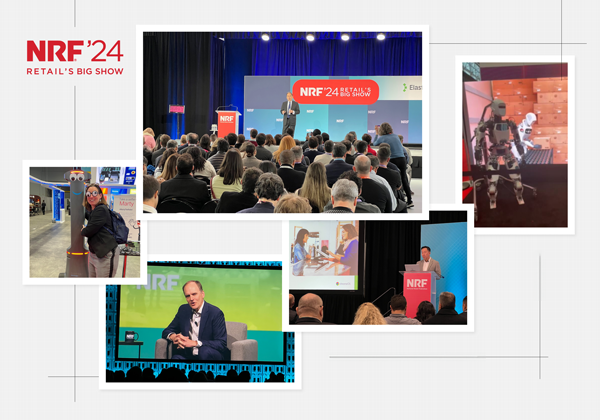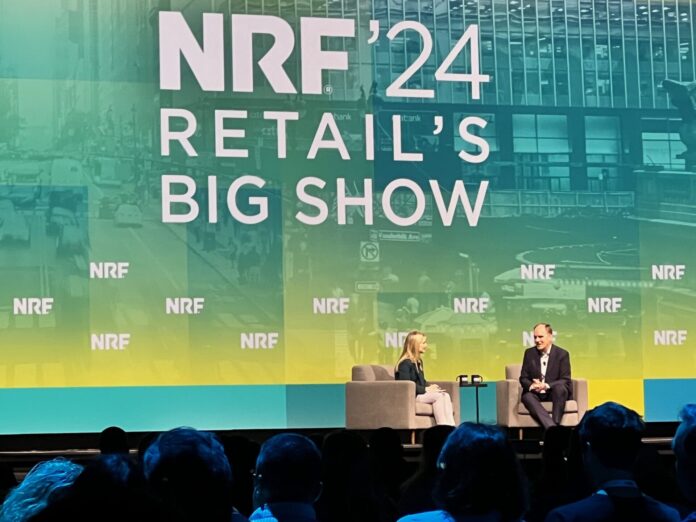It’s not whether you have AI, it’s how you use it.
That was the main theme at the National Retail Federation (NRF) “Big Show,” which recently brought thousands of retailers, technology companies, and customer experience experts together over four days at New York City’s Javits Center.
The topic of AI was everywhere. It dominated panel discussions, powered nearly every product demo on the trade show floor, and featured in economic forecasting discussions.
From legacy brands to emerging retailers, brands are embracing the benefits of AI, grappling with its challenges, and keeping customers top of mind when deciding when and how to implement it.
AI is helping customers and employees
Unlike last year’s Big Show, when conversations focused on the need to implement AI, the conversations retailers are having have shifted. This year, brands aren’t touting the fact that they use AI (since that’s become table stakes at this point); rather, they’re focused on how to best use it to innovate, drive efficiencies, reduce costs, and improve customer experience.
Tractor Supply Co., for instance, which owns about 2,200 stores in 49 states, launched an app called “Hey GURA” that gives associates real-time information and recommendations they can provide to in-store customers. When a customer asks a question, such as what appliances a certain generator can power, an employee can speak the question into wearable technology and the app instantly provides product details about that generator, answers frequently asked questions, and even offers recommendations or alternatives the employee can relay to the customer.
The app has increased customer satisfaction, reduced employee effort, and helped workers gain knowledge about in-store products, said Glenn Allison, Tractor Supply Co.’s vice president of customer-facing applications development.
Discussions elsewhere at the show focused on how retailers are using AI-powered tools to track customers’ buying habits, provide a more seamless experience between digital and in-store shopping, and empower contact center associates by putting more information at their fingertips.
Software developed by Ariadne Maps uses AI to follow people’s movements throughout stores (by tracking signals their cellphones emit) and cull insights from that data. Companies, including global home furnishing brand Ikea, are using the software to see where customers spend their time in stores, how long they spend in-store, and which areas see the most foot traffic.
Ikea uses those insights to inform decisions it makes about store layout and product placement, according to Adriane Maps CEO and Co-founder Georgios Pipelidis. The tool has helped the brand drive sales growth through strategic product placement and improve customer experience, he said.

Workforce impacts are still unfolding
As AI becomes more commonplace, retailers are closely watching how it affects their human workforce. Some brands are using AI-powered robots to stock and unload warehouse shelves, and to monitor inventory on store shelves, and many are using AI to resolve simple customer inquiries – so what happens to the people who used to do those jobs?
AI hasn’t led to a decrease in retail jobs, economists and retailers agree, but it is changing a lot of the work employees do.
It can be challenging to get associates and employees to adopt new technology, so retailers should strive to find AI solutions they can easily integrate into their existing platforms and systems, said Jeff Courcelle, vice president of user experience and chief designer at MicroStrategy.
“The key to adoption is to bring artificial intelligence to where they [employees] already are,” he said.
In many cases, AI isn’t taking jobs away from workers but it is changing job requirements considerably, said Karen Etzkorn, chief information officer of Qurate Retail Group, parent company of QVC, HSN, and other brands. The challenge for retailers, she said, is ensuring employees keep up with the evolving demands of their jobs.
“Our teams are going to be left behind if we don’t upskill them faster,” she said.
Consumer spending continues to bolster economy
During an economic forecast lunch for press and analysts, NRF Chief Economist Jack Kleinhenz said he’s “guardedly optimistic about 2024,” and other economists agreed the U.S. will likely avoid a recession this year.
Despite some headwinds, consumer spending remains strong, which is good news for retailers.
“What’s led this is an extraordinarily resilient jobs market,” said Brian Nagle, senior research analyst and managing director at Oppenheimer & Co. Even though many consumers said last year they would cut back on spending, especially as inflation rose, data shows they didn’t, he said.
If the Federal Reserve lowers interest rates later this year, as many economists predict, that could further bolster consumer spending, said Kenneth Kim, senior economist at KPMG.
In particular, home improvement and home furnishings retailers could see a boost later this year if the Fed lowers mortgage rates and sparks more home sales, Kleinhenz added.
A low unemployment rate and strong job market led to increased holiday retail sales in late 2023 and retailers should be cautiously optimistic about this year too, economists said.

